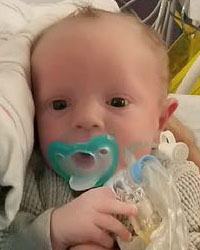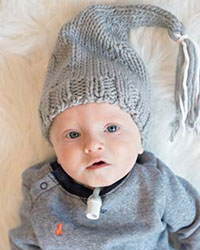 The birth of a child should be one of the most amazing experiences in life, but when you know that your child will be born with a serious medical condition, it becomes a fight for their life from the moment they enter the world. Our sweet Dominic was born with a heart condition called tetralogy of fallot. This congenital condition includes four heart defects – pulmonary stenosis (narrowing of the exit from the right ventricle), a ventricular septal defect (a hole between the two ventricles), right ventricular hypertrophy (thickening of the right ventricular muscle), and an overriding aorta (which allows blood from both ventricles to enter the aorta).
The birth of a child should be one of the most amazing experiences in life, but when you know that your child will be born with a serious medical condition, it becomes a fight for their life from the moment they enter the world. Our sweet Dominic was born with a heart condition called tetralogy of fallot. This congenital condition includes four heart defects – pulmonary stenosis (narrowing of the exit from the right ventricle), a ventricular septal defect (a hole between the two ventricles), right ventricular hypertrophy (thickening of the right ventricular muscle), and an overriding aorta (which allows blood from both ventricles to enter the aorta).
This heart defect can cause oxygen in the blood that flows to the rest of the body to be reduced. Infants with tetralogy of Fallot can have a bluish-looking skin color―called cyanosis―because their blood doesn’t carry enough oxygen. At birth, infants might not have blue-looking skin, but later might develop sudden episodes of bluish skin during crying or feeding. These episodes are called tet spells. Infants with tetralogy of Fallot can have problems including: a higher risk of getting an infection of the layers of the heart, called endocarditis, a higher risk of having irregular heart rhythms, called arrhythmia, dizziness, fainting, or seizures, because of the low oxygen levels in their blood, and delayed growth and development.
As we prepared ourselves for open heart surgery, we also realized shortly after birth that something else was wrong. Dominic also has a high grade 3 subglottic stenosis. Congenital subglottic stenosis occurs when the airway cartilage does not develop normally before birth and results in a narrowing of the airway. Symptoms of subglottic stenosis include shortness of breath during exercise and sometimes at rest, noisy breathing (stridor), cough, recurrent croup, voice changes such as hoarseness, and feeling of mucus in the airway.
 Due to his high grade stenosis Dominic has been deemed a “critical airway.” This condition required a tracheostomy (surgically created hole through the front of Dominic’s neck into his windpipe) and gastrostomy tube (creating an artificial external opening in the stomach for nutritional support) at only 2 weeks old. Dominic spent 3.5 months in different hospitals before undergoing his open heart repair due to the severity of his heart failure. He was able to come home in December still on his ventilator. We worked hard to wean him and officially came off the vent in January.
Due to his high grade stenosis Dominic has been deemed a “critical airway.” This condition required a tracheostomy (surgically created hole through the front of Dominic’s neck into his windpipe) and gastrostomy tube (creating an artificial external opening in the stomach for nutritional support) at only 2 weeks old. Dominic spent 3.5 months in different hospitals before undergoing his open heart repair due to the severity of his heart failure. He was able to come home in December still on his ventilator. We worked hard to wean him and officially came off the vent in January.
Dominic will require airway reconstruction surgery in the future and it presents an entirely new set of medical challenges for our little angel. Unfortunately Dominic is chronically aspirating saliva. This prevents his airway from being repaired now. The cause of this aspiration must be found and treated before surgery to avoid severe complications. The airway team at Cincinnati Children’s Hospital wants to reevaluate him in 6-8 months to see how he is progressing and need to rule out any neurological causes of this problem. In the meantime we are working on everything we can to help him develop otherwise as best as he can. Due to the lack of home nursing availability in Hunterdon County the burden of his care is left on us, his parents. The role of a parent is difficult enough, but now we must adjust to also being the caregivers. Luckily, Dominic’s smile brings us joy every day to push us through hard times.
